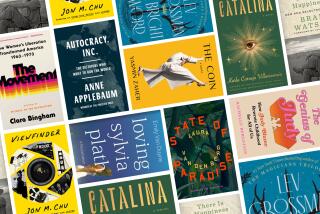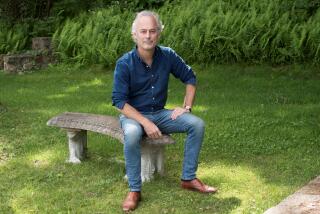Creativity, tradition within Hasidic life
- Share via
Pearl ABRAHAM has made a name for herself writing novels about the tightknit Hasidic communities of her childhood, stories that would fit on the same shelf as the books of Isaac Bashevis Singer. Hers is a world in which the customs and beliefs of early 20th century Eastern Europe live on in parts of contemporary New York, in which the old and the new clash at times, but more often find a way of putting themselves together in a kind of fractured harmony.
Her previous two novels, “The Romance Reader” and “Giving Up America,” focused on strong female characters who run up against the constraints of Hasidism. In her third novel, “The Seventh Beggar,” she creates a larger and much more complex portrait. This is a tale awash in surrealism, fostering a dreamlike quality throughout the narrative that is as fascinating as it is perplexing.
Set in Monsey, N.Y., “The Seventh Beggar,” centers on two young men of successive generations and their ties back in time to the 19th century Hasidic leader, Rabbi Nachman of Bratslav. The tale opens with Joel Jakob, an earnest yeshiva scholar who is the grandson and potential successor of the Berditchev, a leader of one of the Hasidic sects who settled in that part of New York. Joel is exceedingly intelligent and curious. On the verge of adulthood, he becomes enamored with the tales and life story of Nachman of Bratslav, a charismatic Kabbalist and storyteller. (Nachman is a historical figure and great-grandson of the founder of Hasidism, the Ba’al Shem Tov. Nachman is also the author of numerous literary works, among them “Tales of the Seven Beggars,” an unfinished short story that serves as the centerpiece of Abraham’s novel.)
Though Nachman’s work and philosophies are not exactly banned in Joel’s community, many consider them -- with their heavy emphasis on the metaphysical -- unsafe reading, especially for untethered young men. Joel becomes fascinated by Nachman’s thinking and is pulled into his world. As a result, he takes off against his father’s edict to visit Nachman’s grave in the Ukraine and is soon asked to leave the yeshiva run by his father so as not to bring disgrace on the family. Plans for Joel to succeed his grandfather are questioned when Joel begins to experience epileptic-type fits and sinks deeper into his Nachman obsession.
Joel, though, is inexplicably, magnetically drawn to Nachman’s words. “He was here to break the vessel that was Nachman’s work to understand how it was made, and see whether he could reconfigure the shards his own way.” Joel spends hours each day in a drainage channel trying to conjure a woman from the imagined and printed letters of the Hebrew alphabet (as it is claimed early Kabbalists were able to do), and when a massive storm hits the area, he is found mysteriously drowned.
Joel’s devoted sister Ada is a fascinating character who makes a living by adapting the current couture fashions to Hasidic standards of modesty. After Joel’s death, she marries Joel’s best friend and gives birth to a son, JakobJoel, the second main character Abraham’s narrative follows.
Leaping forward in time 20 years, the novel picks up with JakobJoel as a young adult attending MIT. He is being haunted gently by Joel, the uncle he never knew. In a parallel to Joel’s desire to conjure a woman via letters, JakobJoel works to develop “Cog,” a female robot at MIT’s artificial intelligence lab.
Weaving throughout these twin stories are interjections from Nachman’s tales, philosophical discourses between JakobJoel and his dead uncle, and strange stories constructed by Yankel Yankevitch, a badkhn, or wedding jester. These various narrative pieces seem to float near one another, neither separate from the main strand nor inextricably linked.
At the heart of the novel is the problem of originality, with which Joel, Ada, JakobJoel (and implicitly, Nachman) all struggle. “After creation, [Joel] pointed out, no creator is original. To attempt originality is to enter into competition with God.” As each of the characters attempts to create something even remotely new -- a woman made of letters, a new fashion statement, a robot, a story -- they come to see the truth of all creation: “[E]verything new is based on what came before.”
The insight Abraham provides into contemporary Hasidic life is absorbing, but the novel seems fragmentary at times. The MIT sections, in particular, feel almost like science fiction, while the discourses between JakobJoel and Joel are heavily esoteric. Still, if readers can give in to the dreamscape Abraham conjures, leaving behind questions about the how and why of things, her twisting, intellectual and compelling journey into the nature of creativity will be worth the effort.
Bernadette Murphy, a regular contributor to Book Review, is the author of “Zen and the Art of Knitting,” a work of narrative nonfiction.
More to Read
Sign up for our Book Club newsletter
Get the latest news, events and more from the Los Angeles Times Book Club, and help us get L.A. reading and talking.
You may occasionally receive promotional content from the Los Angeles Times.






